
Head Surgery Page Menu: 1 2 3 4 5 6 7 8 9 10 11 12 13 14 Next>>
Head Surgery During the Golden Age of Piracy, Page 7
Non-Trepanning Treatments: Rasping the Bone
The skull was often filed smooth with tools called rasps. This was done to remove damaged (contused) or rough edges from the bone as well as to enlarge the fracture. Richard Wiseman noted that if there be a Fissure [in the skull] so large as to discharge the Serosity [fluid on the brain], you may take more deliberation in laying it open, or rasping the Bone.... [for when] the Fissure [is] considerably large, it is then at your choice whether you will inlarge that Fissure, or continue it for evacuation of the Matter, and forbear the use of the Trepan"1.
With regard to the procedure for rasping, Wiseman explained that when the bone is 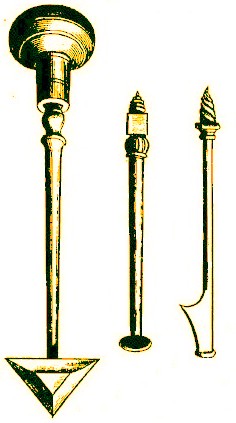
Rasping Tools & Handle, From Thesaurus
Chirurgiae, By Paul Barbette (1687)
damaged "you are to rasp the contused Part the whole length: to which purpose you ought to be furnished with various sorts of Raspatories [rasps]. Whilst you are working with them, the Lips of the Wound ought to be covered with some soft Linen, that you neither hurt them, nor yet the Air offend them."2
This concern about the impact of air on the cranium and the need to rasp the bone when it is so exposed is a regular feature in cases from this time. In the case where the man fell off his horse discussed in the previous section, sea surgeon John Moyle noted with some concern that there was a four hour delay before the wound could be dressed "and all this time his Skul and Wound exposed to the Air, he having only a Handkerchief about it, and it for the most of the time Bleeding."3 When the patient was finally presented to Moyle explains, "I had him into a warm Room, and a good Fire was made, and a Pan of Coles held near his Head."4
Moyle treated the wound as described previously, but on the "next Day when it was opened again, the Bone was receded from its natural Colour, looking rather Evanide [as if it were vanishing]. This was the Effect of the cold Air it had received"5. He redressed the wound, first washing it with hot brandy and vulnerary (healing) herbs several times, but "it would take no Effect... because the Bone had taken the Air, and was altered, and became more smooth than naturally it should be. So that now there was a necessity to use the Radula [a wooden scraper6], the which I did, and rasped until I perceived the Bone to have a Viget [living and vigorous] Colour and a Sanguin Humour [blood red fluid] fleted [oozed] out, bedewing the Part."7
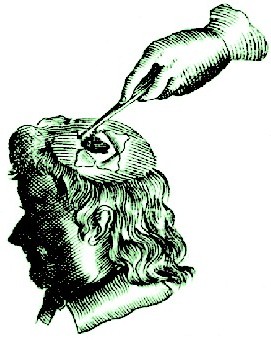
Artist: Jonas Arnold Delineavi
Rasping the Skull, From l'Arcenal de
Chirurgerie,
By
Johannes
Scultetus, p. 116 (1665)
French surgeon Ambroise Paré recommends a similar procedure when a hairline fracture is discovered in the skull using ink. Once a fracture is revealed by the scraping the outer layer of ink off the skull, he tells the surgeon "you must continue scraping untill no sign of the fissure remain, or else untill you come even to the Dura Mater."8 While scraping, Paré advises the surgeon to "bid the Patient, that stopping his nose and mouth, he strive to breath with a great indeavour. For then bloody matter or sanies will sweat through the fissure" if the fracture pierces through the skull. The surgeon must continue scraping the fracture until the dura mater is exposed "with Radula [a toothed rasp] and other scraping Instruments, fit for that purpose".9 Although he notes that a callus will form over the hole created with the rasps, Paré warns that the surgeon that he "must take away as little of the bone as he can, because there is nothing so fit to cover the brain, as the skull"10.
Moyle details another case study which gives an explicit account of the rasping procedure. No other major surgical procedure was used in this case. This account includes a lot of interesting information on how the rasped skull was dressed along with details of the patient's treatment.
In this case, Moyle was faced with damage to the head that had resulted in the periosteum and bone of the skull being "Turpefied [corrupted] and Rough; of an ill Colour, and worse Smell."11 Due to the damage to the bone, Moyle "dressed it up at this time with dry Tow [inexpensive linen cloth], because I knew I must Scale it [remove the dead parts of the bone], either by the Rasp or otherways the next day. I now anointed the Head with Ol. Rosar. and applied an Emplaster of Paracelsus [also called Plaster of Betonica] over it, and made Bandage."12
With that treatment drying the bone, Moyle performed the operation. First, he "defended the Labiæ vulneris [lips of the wound] with fine Linteola [small pieces of lint], and applied the Rasp to the Caries [rotting or damaged] part; (having stopt the Man’s Ears with Cotton before,) and having his Head held steady. I Rasped the whole Breadth of the Caries, and so deep, till I saw a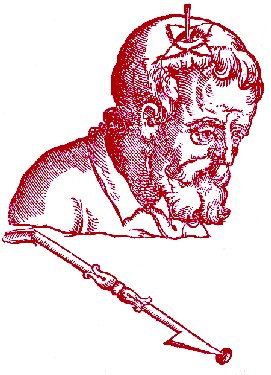
Rasping Tool Shown Used on a Patient, From
Chirgiae Giovanna, By Andrea della Croce (16thc.) sanguine [blood red] Humor follow the Rasp; and in the Rasping I discover’d a Fissure, which obliged me to Rasp deeper in that place, to see if I could Rasp the Fissure out, which I did, for it vanished at the Diplois [Diploë - the spongy, porous, bony tissue between the hard outer and inner bone layers of the cranium]."13
Moyle then applied a variety of medicines and dressings to the head. He started with pieces of flannel soaked in hot red wine and a fomentation "of the Vulnerary Herbs (viz.) Betonic. [betony] Centaur. Hyperic. Absynth. &c."14 He left them on, replacing them with new flannel stupes when they cooled "for a considerable time together."15 The rasped skull was then washed with hot brandy followed by a plaster containing iris florentina, aristolochia rotunda resin, myrrh and aloes. Lint was applied over that. He put a medicine on the lips of the wound to promote healthy growth of the flesh and then rubbed the whole head with chamomile and rose oil. He put a Paracelsus plaster over the head "and a double cloth over that"16.
Next, Moyle bled the patient, gave him an enema and let him drink only ptsyan [ptisan - barley water] or low alcohol beer and to "eat Jusculum tenuern [weak broth], pulmenta [small amounts of meat or fish], Panada [bread soup], &c. By this Treatment dayly Celebrated, the Bone incarned over in a small time, and the Wound healed"17.
1,2 Richard Wiseman, Of Wounds, Severall Chirurgicall Treatises, 1676, p. 380; 3,4 John Moyle, Memoirs: Of many Extraordinary Cures, 1708, p. 26; 5 Moyle, Memoirs:, p. 27-8; 6 John Quincy, Lexicon Physico-Medicum, 1726, p. 397; 7 Moyle, Memoirs:, p. 28-9; 8,9,10 Ambroise Paré, The Workes of that Famous Chirurgion Ambrose Parey, 1649, p.206; 11,12 Moyle, Memoirs, p. 24; 13 Moyle, Memoirs, p. 24-5; 14,15,16,17 Moyle, Memoirs, p. 25
Non-Trepanning Treatments: Raising the Skull
"But when Fractures are made with Bullets or Slugs, there the Hairy scalp and pieces of the Cranium are driven in together upon the Dura mater. In which cases you must presently lay open the Hairy scalp, and raise it up with the Bones, and relieve the opprest Membrane." (Richard Wiseman, Of Wounds, Severall Chirurgicall Treatises, 1676, p. 382)
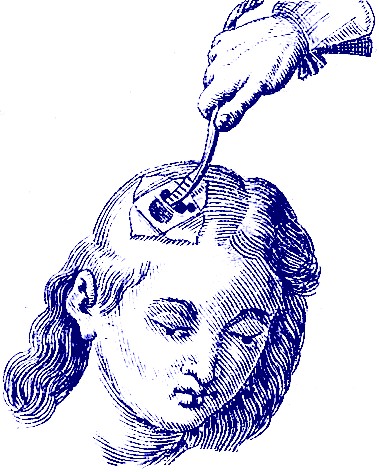
Artist: Jonas Arnold Delineavi
Elevating the Skull, Armamentarium Chirurgicum
Bipartitum,
Johannes Scultetus (1666)
Raising up a depressed section of cranial bone to relieve the pressure on the brain could be used as an alternative to trepanning. Sea surgeon John Woodall explained that sometimes "there is onely a depression, and then a Levatorie [elevator] instrument will excuse the use of a Trapan"1. His simple procedural advises the reader that the way to "cure of wounds in the head, is as followeth.
First let the haire be shaven away, the next if any loose bones be, take them out, the next to be done is, if a depression of the Cranium bee, strive with the elevatorie to raise it."2 Sea surgeon John Atkins (no fan of trepanning as we have already noted) also indicates that a depression in the skull should be 'elevated'3.
Having suggested the elevation of the depressed cranium, Woodall then tries to dissuade his reader from doing so. He explains that it isn't always "needful that the depressed part [of the skull] be presently elevated, except it may very safely and easily be done; for nature will admirably bring to passe the elevating & scaling [casting off of dead bone] of the rest of the fractured or depressed bone in due time, if thou follow onely a good method of applying comforting and convenient medicines to the wound, with apt Ligature."4 Woodall does note that an elevator "is a necessary instrument to elevate the depressed Cranium" although in the same sentence he says "I advise no young Artists to be too curious or hasty to force the depressed bone too much, where there is no evill symptoms"5.
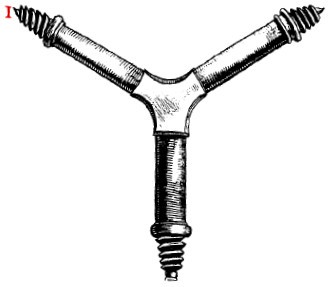
Trefoil, The French Chirurgerie, Jacques Guillemeau
(1598)
In his book, Atkins explains that "there arise some insuperable Difficulties in an immediate elevating [of] any depressed Part of the Skull."6 He explains that since the adult skull "will like Iron, or other hard malleable Bodies, require as much Force to straiten, as bent it... The Elevator it [the operation] is attempted with must be of fine Make, or it will not be so safely introduced between the inner Lamina [inner table] and Dura Mater; and the finer the Instrument, the less Force can be used"7.
Atkins also addresses the defects in the use of a trefoil (which he refers to as a 'tirefond'). This is a three armed tool often with screws on the end of each arm which can be used to screw into the skull so that the surgeon can pull the sunken skull up. (See the image at left.) His objections to the trefoil are that it often doesn't work and it may cause fluid buildup beneath the skull on the dura mater (presumably either by accidentally piercing the dura mater or creating more pressure on the skull while it is being screwed in).8
Perhaps in support of their admonitions not to elevate the depressed bone of the skull (even while agreeing that elevation was a valid procedure), neither Woodall nor Atkins provide a detailed procedure for the operation. This lack of detail may have been due to the simplicity of using tools like an elevator to raise a depressed skull.
German surgeon Johannes Scultetus provides more lengthy descriptions of the surgical procedures for raising a skull using some of the tools mentioned. For example, in the
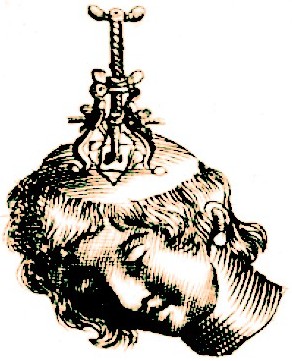
Artist: Jonas Arnold Delineavi
Raising the Skull with a Terebra, From l'Arcenal de
Chirurgerie,
By
Johannes
Scultetus, p. 116 (1665)
case where there is a contusion with a depressed cranium without a wound, he recommends the use of a variety of tools designed to raise a depressed cranium. First he directs the surgeon to cut the scalp over the depression, with the incised skin being
kept with pellets open; not only that the Chirurgian may be more certain whether the skull be cleft; but also that if there be a chink [crack] with the depression (which is very much to be feared) a Levitor [elevator], that is a convenient instrument, may be made use of.
The next day after the incision of the skin... We must take the triangular part of the Trefine [trefoil]... wherewith we must gently bore the skull in the center of the depression, yet not beyond the outward Table, Having made a hole with the Trefine, the Piercer of the Triploides [Terebra - see image at right] must be fastned on, and must be so long turned about by means of a screw above, until it take a little hold of the inward Table [of the skull]; then the skull, pressed down, must be raised up perpendicularly, by turning the lower screw of the Triploides back again. The skul being raised that was pressed down, the instrument called Triploides must be removed; and the wound must be dressed9.
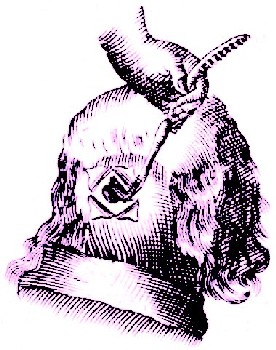
Artist: Jonas Arnold Delineavi
Raising the Skull with an Elevator, From l'Arcenal de
Chirurgerie,
By
Johannes
Scultetus, p. 116 (1665)
None of the sea surgeons mention using a terebra in their texts. In all of John Woodall's various tool diagrams, he does not figure one. Without more information, it is impossible to say why this is so. The variety of possibilities may include its difficulty of use on ship, the lack of expertise of many sea surgeons (who were often just starting their surgical careers), the limited usefulness of the tool or its cost versus the likelihood that it would be used.
In another surgical situation, Scultetus says that when there is a fissure near the depression in the skull, "if the crack be broad, and the depression not great, the skull must be raised with a Levitor [elevator]."10 Like the sea surgeons, Scultetus scrimps on explanation for the use of elevators for raising the skull, perhaps pointing to the simplicity of the operation.
While Richard Wiseman hasn't much to add to the operation of the elevator, he does give some interesting information on what to do after the damaged, sunken skull has been prised up. "If the Flux of bloud be great, cleanse it with a Sponge dipt in Red wine or Vinegar, and dress it as hath been shewed."11
The dressing to which Wiseman refers here is applicable not only to this operation, but to many other head wounds, so it is discussed in detail later in the section 'Post Operation: Treating Wounds of the Head.'
1 John Woodall, the surgions mate, 1617, p. 135; 2 Woodall, p. 135-6; 3 John Atkins, The Navy Surgeon, 1742, p. 84; 4 Woodall, p. 5-6; 5 Woodall, p. 7; 6 Atkins, p. 84; 6 Atkins, p. 84-5; 8 Atkins, p. 85; 9 Johannes Scultetus, The Chirurgeons storehouse, 1674, p. 128-9; 10 Scultetus, p. 129-30; 11 Richard Wiseman, Of Wounds, Severall Chirurgicall Treatises, 1676, p. 382

